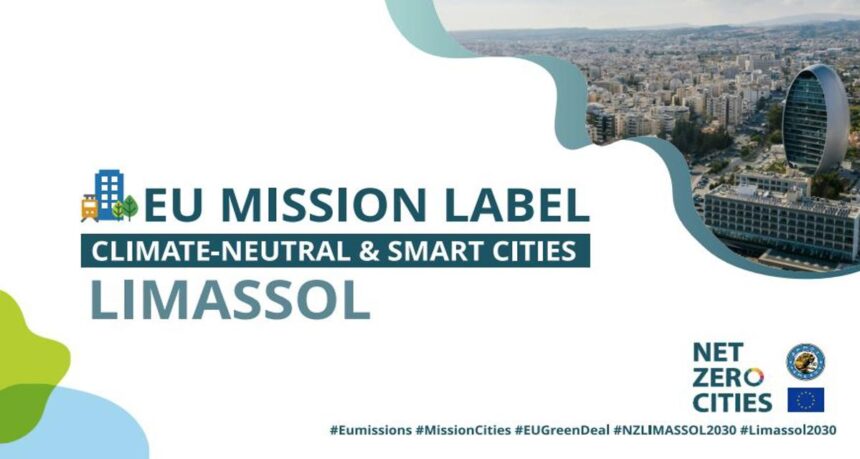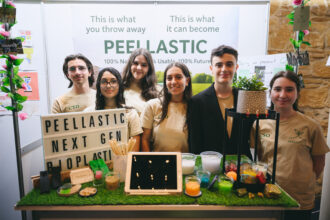Limassol has officially joined the group of 100 European cities selected to participate in the EU Mission for Climate-Neutral and Smart Cities, widely known as Net Zero Cities. This ambitious program targets climate neutrality for participating cities by 2030, positioning them as forerunners for all European cities aiming for the same goal by 2050.
As the sole Cypriot city selected, Limassol’s participation in this transformative endeavor marks a significant achievement for Cyprus and the broader Eastern Mediterranean. Driven by a blend of innovative urban planning, strong public-private collaborations, and active citizen involvement, the city is set to spearhead the transition towards a more sustainable and resilient future.
What are Net Zero Cities?
Net Zero Cities are part of the European Commission’s Missions under Horizon Europe, designed to tackle some of the greatest challenges facing our society. The 100 chosen cities will act as living laboratories—testing and scaling solutions for clean mobility, energy-efficient buildings, and renewable energy, while also promoting green urban spaces and citizen well-being.
These cities will receive tailored support, access to dedicated funding mechanisms, and opportunities to collaborate with peers across Europe to co-develop and implement Climate City Contracts—a novel governance and planning framework that integrates social, technological, and regulatory innovations.
Why Limassol?
While Limassol’s inclusion in the Net Zero Cities initiative marks a significant step forward, the city has so far taken only minimal action on climate and sustainability. Efforts such as green infrastructure, bike lanes, and urban cooling have been limited both in scale and scope. This programme now offers Limassol a unique opportunity—and responsibility—to accelerate meaningful change, embed sustainability into urban planning, and turn climate ambition into measurable progress. The city’s climate vulnerabilities, particularly its exposure to heatwaves and rising sea levels, make its participation in the programme not only timely but critical.
Key areas of focus for Limassol’s Net Zero Transition:
• Energy efficiency in buildings: Buildings are significant contributors to urban emissions. Retrofitting existing buildings with better insulation, energy-efficient windows, and smart building management systems will be crucial. Furthermore, promoting the construction of new, highly energy-efficient buildings adhering to the latest green building standards will be essential. Incentives and regulations can play a vital role in driving this transition. For example, offering tax breaks for energy-efficient renovations or mandating energy performance certificates for buildings can encourage widespread adoption.
• Renewable energy deployment: Transitioning to clean energy sources is paramount. Limassol has the potential to harness solar energy extensively, both on rooftops and through larger-scale solar farms in suitable locations. Exploring other renewable sources like wind energy, where feasible, and integrating them into the city’s energy grid will be vital. Streamlining permitting processes for renewable energy installations and offering financial support can accelerate their deployment.
• Sustainable transportation: The transport sector is a major source of emissions in urban areas. Limassol will likely focus on promoting public transportation through improved infrastructure, increased frequency, and the adoption of electric buses. Encouraging active mobility through the development of safe and accessible cycling lanes and pedestrian walkways will also be key. Furthermore, supporting the adoption of electric vehicles through charging infrastructure and incentives for residents and businesses will contribute significantly to reducing transport emissions.
• Waste management and circular economy: Moving away from the “take-make-dispose” model, Limassol can reduce emissions and its dependence on finite resources by embracing a circular economy. This means improving waste sorting and recycling, encouraging less waste through education and smarter packaging, supporting businesses that reuse materials, starting a composting for organic waste, and exploring ways to turn non-recyclable waste into clean energy. These steps can help Limassol treat waste as a resource, cut emissions, and build a greener local economy in line with its Net Zero goals.
• Smart city technologies: Integrating smart technologies can optimize energy consumption, improve traffic flow, and enhance the efficiency of various urban services. Smart grids, intelligent lighting systems, and data-driven urban planning can contribute to significant emissions reductions and improve the overall quality of life for residents. For instance, smart sensors can monitor energy usage in real-time, allowing for adjustments to optimize consumption.
• Green infrastructure and nature-based solutions: Investing in green spaces, such as urban parks and green roofs, can help absorb carbon dioxide, reduce the urban heat island effect, and improve air quality. Protecting and enhancing existing natural areas within and around Limassol will also be crucial for building resilience to climate change impacts. Planting more trees along streets and in public spaces can provide shade and further contribute to carbon sequestration.
Opportunities and benefits for Limassol:
• Improved air quality and public health: Reducing emissions will lead to cleaner air, resulting in fewer respiratory illnesses and a healthier population.
• Enhanced quality of life: Quieter streets, more green spaces, and a more sustainable environment will contribute to a higher quality of life for residents.
• Economic growth and innovation: The transition to a green economy will create new jobs in renewable energy, energy efficiency, sustainable transportation, and other related sectors. It will also foster innovation and attract green businesses.
• Increased energy independence and security: Reducing reliance on fossil fuels will enhance the city’s energy independence and protect it from volatile global energy markets.
• Enhanced resilience to climate change: By mitigating the causes of climate change, Limassol will become more resilient to its impacts, such as heatwaves and water scarcity.
• International recognition and leadership: Being a frontrunner in the Net-Zero Cities program will enhance Limassol’s international reputation and position it as a leader in urban sustainability.
What’s next?
Limassol will now begin the process of drafting its Climate City Contract, involving a wide range of stakeholders: from local government and businesses to academia and civil society. Additionally, citizens will play a central role in the transition. Public consultations, co-design workshops, and community-driven projects will be key elements in shaping Limassol’s future.
Achieving net-zero by 2030 is an ambitious undertaking that requires collaboration, innovation, and commitment from all stakeholders – the local government, businesses, residents, and research institutions. Engaging the community in the transition process, raising awareness about climate change and sustainable practices, encouraging changes in daily habits, and fostering a sense of shared responsibility will be crucial for success.
Limassol’s journey towards becoming a net-zero city is not just about reducing emissions; it’s about building a more sustainable, resilient, and thriving future for generations to come. By embracing innovation and working together, Limassol can serve as an inspiring example for other cities in Cyprus and across Europe. The commitment to the Net-Zero Cities program signals a bold step towards a greener and more prosperous future for this dynamic Mediterranean city.











